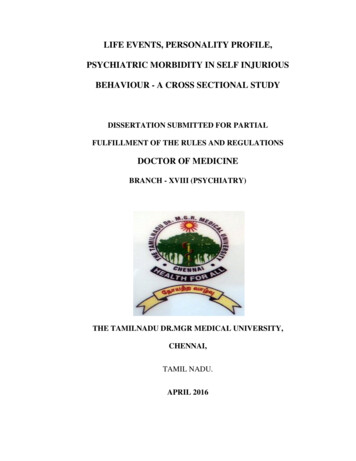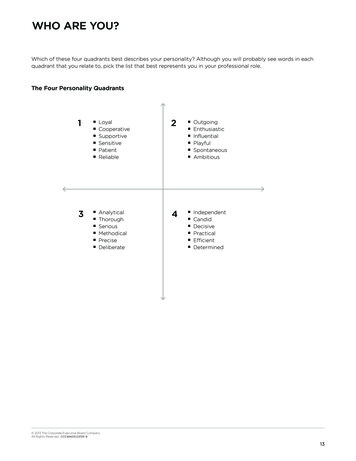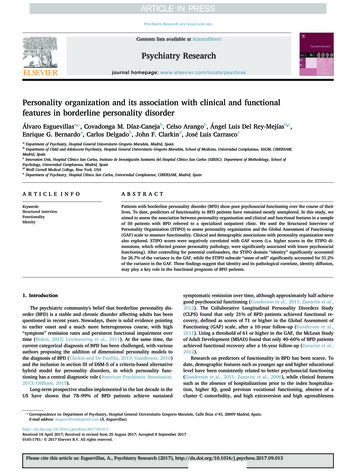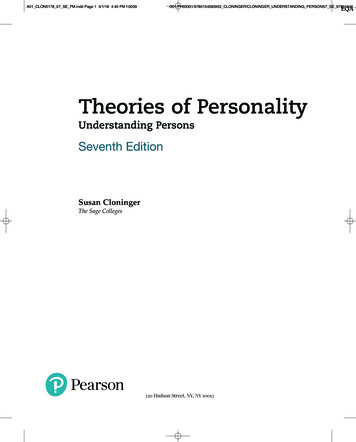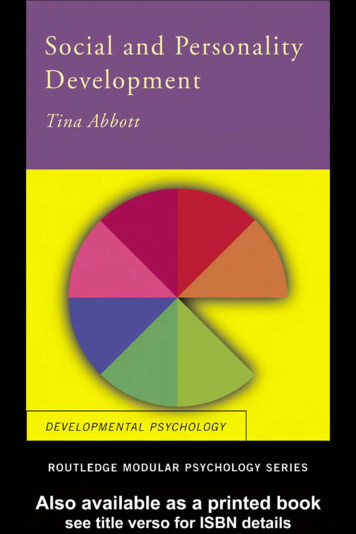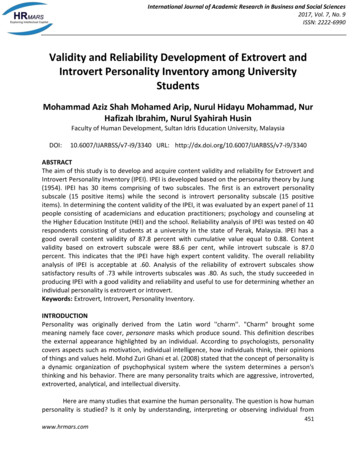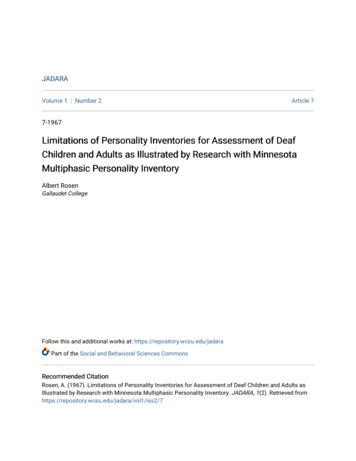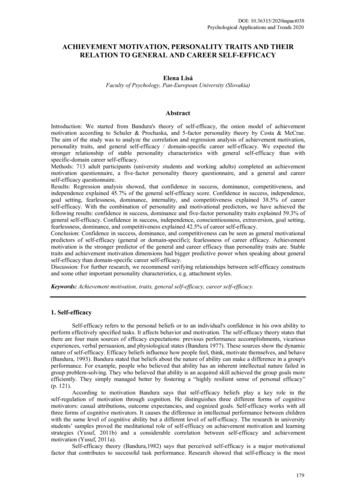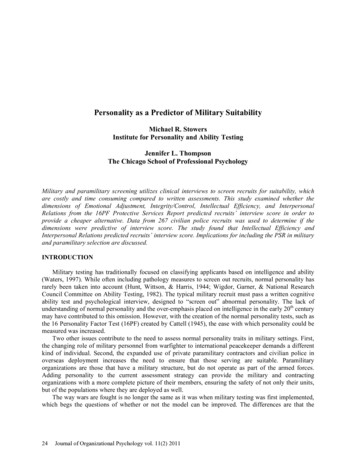
Transcription
Personality as a Predictor of Military SuitabilityMichael R. StowersInstitute for Personality and Ability TestingJennifer L. ThompsonThe Chicago School of Professional PsychologyMilitary and paramilitary screening utilizes clinical interviews to screen recruits for suitability, whichare costly and time consuming compared to written assessments. This study examined whether thedimensions of Emotional Adjustment, Integrity/Control, Intellectual Efficiency, and InterpersonalRelations from the 16PF Protective Services Report predicted recruits’ interview score in order toprovide a cheaper alternative. Data from 267 civilian police recruits was used to determine if thedimensions were predictive of interview score. The study found that Intellectual Efficiency andInterpersonal Relations predicted recruits’ interview score. Implications for including the PSR in militaryand paramilitary selection are discussed.INTRODUCTIONMilitary testing has traditionally focused on classifying applicants based on intelligence and ability(Waters, 1997). While often including pathology measures to screen out recruits, normal personality hasrarely been taken into account (Hunt, Wittson, & Harris, 1944; Wigdor, Garner, & National ResearchCouncil Committee on Ability Testing, 1982). The typical military recruit must pass a written cognitiveability test and psychological interview, designed to “screen out” abnormal personality. The lack ofunderstanding of normal personality and the over-emphasis placed on intelligence in the early 20th centurymay have contributed to this omission. However, with the creation of the normal personality tests, such asthe 16 Personality Factor Test (16PF) created by Cattell (1945), the ease with which personality could bemeasured was increased.Two other issues contribute to the need to assess normal personality traits in military settings. First,the changing role of military personnel from warfighter to international peacekeeper demands a differentkind of individual. Second, the expanded use of private paramilitary contractors and civilian police inoverseas deployment increases the need to ensure that those serving are suitable. Paramilitaryorganizations are those that have a military structure, but do not operate as part of the armed forces.Adding personality to the current assessment strategy can provide the military and contractingorganizations with a more complete picture of their members, ensuring the safety of not only their units,but of the populations where they are deployed as well.The way wars are fought is no longer the same as it was when military testing was first implemented,which begs the questions of whether or not the model can be improved. The differences are that the24Journal of Organizational Psychology vol. 11(2) 2011
definition of the enemy is no longer clear and the military is being forced outside of their normal role andduties.Historically wars were fought between clearly defined enemies. However, from the Vietnam Warthrough the ongoing war in Iraq, enemy tactics have changed (Alexander, 2005). There are no cleardefinitions of the “bad guy” and this puts a completely new type of stress on personnel serving in theseconflicts. Second, guerilla warfare, or what the military refers to as asymmetric warfare, is the commonmethod of fighting now, where anyone at anytime can be the enemy (Gray, 2004). These small unitactions are not the clear-cut battlefields of the past.Another strain on the armed forces is the increasing expansion of their duties. The armed forces aretrained to be a combat force, not trained as peacekeepers, but find themselves in the role of peacekeepersmore and more (Noyes, 1995). They may also be pressed into service as prison guards for the sameenemy combatants they were trained to kill. Together, these new responsibilities stretch personnel beyondtheir training and often beyond the skills they were tested for when enlisting (Gordon, 2006).Furthermore, armed forces are being supplemented by what are known as paramilitary and civilianpolice personnel. These persons are employed by private organizations and receive training different tothose enlisted in the armed forces. Often times the two forces, enlisted and private, are deployed alongside one another and are required to work together (Gomez del Prado, 2008). There can often be conflictbetween these groups as they are not only trained differently, but they have different incentives as well(Michaels, 2004). This conflict can prevent the necessary communication between the two forces, andcomplicate the oversight necessary to ensure mission completion.Given the changes described above it can be seen that military and paramilitary personnel will need topossess certain traits to help them succeed. By being stress-resilient they could be better prepared for thestress encountered on an asymmetric battlefield. Also, it will be necessary to have the ability to makedecisions with limited information and have the ability to be confident in those decisions. Finally, theability to interact with others, including those who are vastly different from oneself, is crucial to adaptingto the new partnerships seen in warfare. Normal psychological traits, such as emotional adjustment,intellectual efficiency, interpersonal relations as well as integrity and control could help both military andparamilitary organizations “screen in” the most suitable candidates.Unfortunately, evidence is beginning to show that personnel, both enlisted and private, are lacking thequalities necessary to perform well. In 2007, 14 members of a 27-member team of the private securitycompany Blackwater were accused of killing 17 Iraqi civilians during an unauthorized traffic blockade(World News Digest, 2008). The team was investigating an alleged car bombing when they attempted tostop a car. They opened fired on the car and continued to shoot nearby civilians, even shooting anunarmed man as he tried to surrender (World News Digest, 2008). There were 13 exonerated members ofthis team that were reported to behave opposite to the 14 implicated. What were the differences betweenthese two groups?Although the personnel, including the 14 implicated, had passed all selection and screening tests, theBlackwater incident suggests there could be some fundamental difference between the two that causedthem to behave so drastically different. Could the difference have been their fit in terms of normalpersonality? This case helps to illustrate that screening military and paramilitary personnel for the absenceof mental impairment may not be a sufficient selection method, given what we know of the changingdemands of military personnel.In April of 2004, evidence surfaced of US armed forces personnel abusing and torturing Iraqiprisoners at the Abu Gharib facility in Iraq. Those involved were charged with a variety of crimes andrecommended for court martial (World News Digest, 2004). These soldiers had passed all the traditionalability measures, but there was no testing to indicate whether their personalities were ideal to cope withthis type of stress. Together, this creates an implication that there could be non-pathologicalcharacteristics outside of cognitive ability that account for why a person may act inappropriately while ina position of authority.Examples like these help to illustrate the current procedure of screening enlisted and private militarypersonnel based on cognitive ability and lack of pathology is insufficient. In order to preserve the safetyJournal of Organizational Psychology vol. 11(2) 201125
of the civilians and the reputation of the US forces stationed there, it is imperative that events like theBlackwater killings and Abu Gharib abuse be prevented. Personality testing has a place in helping tomake sure these events are not repeated. By evaluating the ways in which people will interact on anconstant basis, as well as looking at whether or not an individual possess the key normal personalitycharacteristics identified for success in protective services positions situations like these can be preventedin the future.Given the shortcomings in the current pathology-only screening model, the changing jobrequirements, and the inclusion of paramilitary forces, the current military selection methods are costlyand may not be anymore valid than self-report assessment procedures based on normal personality. Themajor disadvantages of the psychologist interview in military and paramilitary selection are theinvestments of large amounts of money and personnel time. In 2008, the military added 195,972 newrecruits (Department of Defense, 2009). The resources required to provide the psychological screening toall of these recruits are quite large (Society for Industrial and Organization Psychologists, 2009). Theresult is a large expenditure in time of military psychologists and often the need to bring in civilianpsychologists who may charge more than what the military would pay their own personnel. Although theinterview model provides a good basis for selection, the question remains if there is a more efficient, costeffective, and equally valid way to screen recruits.Self-report personality questionnaires that assess normal personality may present a way to conductscreening that is more efficient in terms of time and costs significantly less than interviewing (Society forIndustrial and Organization Psychologists, 2009). Instead of conducting one-on-one interviews todetermine suitability, assessments can be given to large groups at once. With the advent of computerizedtesting, there is also little need to purchase perishable materials. The use of a self-report personalityassessment as a screening tool instead of the interview would not only save military and paramilitaryorganizations money, but it would also reduce the overall time to matriculate new recruits. A measure ofnormal personality could provide a viable screening assessment that reduces interpersonal bias that maybe present in an interview (Dougherty, Turban & Callender, 1994) and adds additional information, suchas integrity, that may be difficult if not impossible to assess in an interview.The Protective Services Report (PSR) provides a specialized personality screening measure for use inmilitary and private military contractor selection. The PSR was developed directly from the 16Personality Factor Questionnaire (16PF) and as a result is grounded in normal personality theory.Furthermore, the specialized dimensions of the PSR have been shown to predict job outcomes relevant tothe armed forces by the Institute for Personality and Ability Testing (IPAT) (2007). By looking at thenormal personality characteristics, it becomes possible to move beyond a “psychologically unfit” screenout model and to begin to look at what makes a successful protective services agent.What sets the PSR apart from a standard 16PF interpretation report is the creation of four extradimensions created exclusively for protective services positions. The four protective service dimensionswere originally created from a content analysis of law enforcement literature (IPAT, 1987). Thedimensions are made up of combinations of the 16PF’s primary factors.Emotional adjustment is the first of the protective services dimensions and relates to how a personresponds to challenging situations. A candidate who is emotionally adjusted will be better able to copewith the stress and challenges of the new battlefield. Integrity/control is the next dimension and evaluateswhether the applicant is likely to act in a dependable and conscientious manner, suggesting the ability tofollow orders and comply with established rules of engagement. Intellectual efficiency corresponds to thedecision making style of the applicant and their ability to solve problems, indicating their ability to makeand remain confident in the critical decisions they will have to make. The last protective servicesdimension is interpersonal relations, which evaluates how an applicant relates to others and theirpreference for solitude and independence, which could dictate how well the candidate will interact withdifferent people and the degree to which they will effectively interact with civilians (IPAT, 2007.)The four PSR dimensions have been shown to indicate success across different areas of military andparamilitary work. Criteria have included things such as training success, being hired, job knowledge, and26Journal of Organizational Psychology vol. 11(2) 2011
work behaviors (IPAT, 2007). These relationships help to demonstrate the use of the PSR dimensions as ascreen in tool for selection.As the clinical interview currently serves as the decision component as to whether a candidate isdeployable or not, it is imperative to show that any potential replacement can replicate the results of thatinterview. Given the secure nature of military and paramilitary organizations, it is nearly impossible toobtain external criteria validation such as performance. Using the existing interview as the performancecriteria for this study provides a known and organizationally accepted comparison for the screeningability of the PSR dimensions. The results of this study will begin to illuminate if the PSR has thepotential to provide less costly and more efficient assessment alternative to the clinical interview, as wellas potentially more useful information.HypothesesThis study will test whether:1. The PSR dimension of emotional adjustment will positively predict the clinical interviewscore.2. The PSR dimension of integrity/control will positively predict the clinical interview score.3. The PSR dimension of intellectual efficiency will positively predict the clinical interviewscore.4. The PSR dimension of interpersonal relations will positively predict the clinical interviewscore.Furthermore, the study will test through linear regression whether gender moderates the relationshipbetween the PSR dimensions and the interview score. Evaluating the role of gender is important, as anyselection procedure needs to be fair and free from adverse impact. Finally, the research question ofwhether the clinical interview score is more important to the overall recommendation will be explored bylogistically regressing the overall recommendation on the PSR composite and the interview score.METHODParticipantsThe sample consisted of 267 first-time recruits for paramilitary positions in various countries acrossthe globe. The sample was predominantly male (84.6%) in makeup.MeasuresThe PSR is a specialty report generated from Raymond Cattell’s 16PF that is used to select applicantsfor high-risk occupations, such as military and paramilitary service. The 16PF is a self-report measure ofnormal adult personality. The 16PF is written at a fifth grade reading level, and is currently in its fifthedition which, has a norm sample that approximates the demographic breakdown of the population fromthe 2000 U.S. Census. It is made up of 185 items, which comprise 16 primary factor scales and 5 globalfactors (IPAT, 1994). The PSR also reports 4 additional dimensions specific to performance in high-riskoccupations: Emotional Adjustment, Integrity/Control, Intellectual Efficiency, and InterpersonalRelations.The PSR dimensions are scored on the Sten scale. Scores of 3 or less are considered to be belowaverage, with scores between 4 and 7 considered average, and 8 or greater being above average. HigherPSR dimension scores are considered to be better and represent a stronger embodiment of the trait.PSR Dimension: Emotional AdjustmentEmotional adjustment and relates to how a person responds to challenging situations. High scorerstend to remain calm and act appropriately in uncertain situations. They also tend to be in control of theiremotions during tense situations. Emotion adjustment has a linear composite reliability of .76 and a 7month test-retest reliability of .83 in the norm sample. Reliabilities were not calculated for the studysample, as item level data was not made available.Journal of Organizational Psychology vol. 11(2) 201127
PSR Dimension: Integrity/ControlIntegrity/Control evaluates whether the applicant is likely to act in a dependable and conscientiousmanner. High scorers tend to have well-developed standards of discipline and tend to be rule followers.They also tend to fulfill their duties and responsibilities. The integrity/control dimension has a linearcomposite reliability of .83 and a 7-month test-retest reliability of .77 in the norm sample. Reliabilitieswere not calculated for the study sample, as item level data was not made available.PSR Dimension: Intellectual EfficiencyIntellectual efficiency corresponds to the decision making style of the applicant and their ability tosolve problems. High scorers are able to easily understand abstract issues, and tend to be quick anddecisive when making decisions. The linear composite reliability of the intellectual efficiency dimensionin the norm sample is .83, and a 7-month test-retest reliability of .71. Reliabilities were not calculated forthe study sample, as item level data was not made available.PSR Dimension: Interpersonal RelationsInterpersonal Relations evaluates how an applicant relates to others and their preference for solitudeand independence. High scorers tend to prefer working with others cooperatively and tend to valueinteraction. Interpersonal Relations has a linear composite reliability of .89 and 7-month test-retestreliability of .78 in the norm sample. Reliabilities were not calculated for the study sample, as item leveldata was not made available.PSR Overall ScoreCandidates also receive an overall score for the PSR assessment. The overall score is the average ofall 4 PSR dimensions. The overall score is used a quick reference, as those with below average scoresacross the PSR dimensions will inevitably have low overall scores.Clinical InterviewThe applicants were also assessed using a standardized interview. The interview was created for theclinical evaluation of the same dimensions as the PSR in order to create a clinical comparison and checkof the four PSR dimensions. The interview consists of five questions. Four of the questions evaluate eachof the respective four PSR dimensions, and the last question assesses the readiness of the recruit forservice. Each question is rated on a 1 to 9 scale, with 1 being poor and 9 being exceptional. The scores foreach question are summed together to create an overall score for the applicant, with a cutoff score forpassing set at 25.Final RecommendationAfter both assessments have been administered, a final recommendation of pass/fail is made. TheFinal Recommendation is a subjective judgment based on the psychologist’s interpretations of the ratingsfrom both the PSR and the interview.GenderGender is categorized as male and female. This variable will be used to assess whether gender plays arole in suitability ratings.ProcedureAll data is archival data that was obtained by permission from IPAT. In order to examine therelationship between the four PSR dimensions and the interview score a multiple regression analysis wasconducted. The interview score will be regressed onto the four dimensions in hope of finding a significantregression model. Gender will be included in a second regression model as a moderator to determine if ithas a role on the overall test performance of the applicants. How much influence the clinical interviewrecommendation has on the final recommendation will be examined by using logistic regression. The28Journal of Organizational Psychology vol. 11(2) 2011
overall PSR score and interview score will be used to attempt to correctly classify the candidates’ finalrecommendations made by the clinical psychologists.RESULTSPSR RegressionIn order to test hypotheses 1 through 4 the interview score was regressed on the PSR dimensions ofEmotional Adjustment, Integrity/Control, Intellectual Efficiency, and Interpersonal Relations. Themultiple regression model was significant F (4, 261) 16.57, p .001. This suggests that the PSRdimension scores are able to predict the Interview Score for candidates. The regression model accountsfor approximately 20% (R2 .20) of the variance in the Interview Score.Table 1 shows the descriptive statistics and correlations for all variables in the study. Table 2shows coefficient results for each of the 4 PSR dimensions. From the table we can see IntellectualEfficiency is a significant predictor of Clinical Interview score, b 1.00, t(261) 4.12, p .001. Thisresult provides support for hypothesis three; Intellectual Efficiency will positively predict ClinicalInterview score. This result means that as a candidate’s Intellectual Efficiency increases, their ClinicalInterview score will also tend to increase.TABLE 1STUDY VARIABLE CORRELATION MATRIX (N -.047.01.97PSR Composite-.13*34.736.06Interview Score.03Final.32.82Recommendation-.01* Correlation is significant at the 0.05 .33**-.42**-.49**** Correlation is significant at the 0.01 levelTABLE 2PSR DIMENSION REGRESSION COEFFICIENTS (N 267)PSR DimensionEmotional AdjustmentIntegrity/ControlIntellectual EfficiencyInterpersonal 3t1.861.144.123.98p.06.25.00.00Also it can also be seen that Interpersonal Relations is a significant predictor of Clinical Interviewscore, b .81, t(261) 3.98, p .001. This result provides support for hypothesis four; InterpersonalJournal of Organizational Psychology vol. 11(2) 201129
Relations will positively predict Clinical Interview score. This result means that as a candidate’sInterpersonal Relations score also increases, their interview score will also tend to increaseHypothesis one, Emotional Adjustment will positively predict Clinical Interview score, was notsupported. However, the results approach traditional significance b .69, t(261) 1.86, p .06. This mayindicate a trend that would be significant in a larger sample. Hypothesis two, Integrity/Control willpositively predict Clinical Interview score was also not supported.Gender ModerationIn order to test the hypotheses that gender does not moderate the relationship between the PSRdimensions and Clinical Interview score, another regression was run. In addition to the PSR variables,four moderation vectors were included in the regression. These vectors were created by multiplying eachparticipant’s PSR dimension scores by their gender code.The resulting regression model was significant F(8, 257) 9.04. p .001. The model accounted for22% (R2 .22) of the variance in Clinical Interview score. However, none of the moderation vectors weresignificant predictors of the Clinical Interview score. This means that gender does not determine therelationship between the PSR dimensions and the candidate’s interview score. These results providesupport for hypothesis five that gender will not moderate the PSR dimension and Clinical Interviewrelationship. Table 3 shows the resulting coefficients for the regression.TABLE 3GENDER MODERATION REGRESSION COEFFICIENTS (N 267)PSR DimensionEmotional AdjustmentIntegrity/ControlIntellectual EfficiencyInterpersonal RelationsEmotion Adjustment x GenderIntegrity/Control x GenderIntellectual Efficiency x GenderInterpersonal Relations x nce of Clinical InterviewIn order to answer the research question of whether the Clinical Interview Score is more influentialthan the PSR Overall Score in making the Final Recommendation (pass/fail), logistic regression wasused. The logistic regression model was significant χ2 34.05, p .001. The chi-square results suggestthe model is different from chance alone. Large values of -2 log likelihood indicate a poorly fitting model,which is not the case here. The results then suggest that model is useful for classifying candidates intowhether or not they receive a pass or fail for their Final Recommendation. Nagelkerke R2, which is anindirect analog for traditional R2 for the model was .53. Larger values of Nagelkerke, such as seen here,suggest a more significant prediction model. The model predicts the Final Recommendation with 98.3%accuracy.Table 4 gives the coefficient information for both the PSR Overall Score and Clinical Interview score.From the results the Clinical Interview score emerges as the sole predictor of the Final Recommendationb .40, Wald 9.10, p .001. The results of the logistic regression seem to confirm that thepsychologists view their Clinical Interview score as a larger contributor than the PSR Overall Score whendetermining the final pass or fail recommendation for a candidate.30Journal of Organizational Psychology vol. 11(2) 2011
TABLE 4LOGISTIC REGRESSION COEFFICIENTS AND STATISTICS (N 231)PSR AverageInterview Scoreb (S.E.).55 (.53).40 e results of this study indicate that the Clinical Interview Scores of paramilitary candidates can bereliably and accurately predicted from the PSR dimensions of Intellectual Efficiency and InterpersonalRelations. Those candidates who had higher scores on both dimensions tended to perform better duringthe clinical interview than those with lower scores. Similar, but approaching significant results were alsoseen with the Emotional Adjustment dimension from the PSR. These results suggest that the PSR couldserve as cheaper, more easily administered alternative to the traditionally cumbersome clinical interview,once validated with performance data.The relationship between Intellectual Efficiency and the clinical Interview Score makes conceptualsense. The interview presents candidates a series of novel and somewhat ambiguous questions andrequires the applicants to form a response in a short time period. Intellectual Efficiency represents theability to make decisions based on limited information and to have confidence in that information. Thosewith higher scores could find it easier to formulate acceptable answers to the questions asked during theinterview, and would furthermore present confidence in their answer. Given the need for the candidate torepeatedly be able to utilize this skill throughout the interview the strength of Intellectual Efficiency canbe explained. Even though only one question is directly asked in the interview to evaluate this dimension,the candidate uses the related skills throughout the whole interview.The relationship between Interpersonal Relations and the Interview Score should be immediatelyapparent. The entire interview process is an interpersonal exchange between the candidate and theinterviewer. Again, although only one question in the interview process directly addresses interpersonalskills, the candidate must be able to present a warm, friendly, and communicative demeanor during theentirety of the interview. Those with higher Interpersonal Relations scores on the PSR will genuinely bemore friendly, open to interaction, and able to communicate with others. It stands to reason then that thosewith higher Interpersonal Relations scores will be better able to handle the social exchange that takesplace during the interview process.Also interesting is that Emotional Adjustment approaches significance when attempting to predict theinterview score. It may be that some candidates find the interview more stressful and as such have todemonstrate more control over their emotional state than those who don’t feel as stressed. This may havemade it easier for those with higher Emotional Adjustment to demonstrate their skills directly, rather thanindirectly through the interview question.Another more interesting conclusion is that perhaps the interview is only successful at evaluating acandidate’s Intellectual Efficiency and Interpersonal Relations. If this is in fact the case, it strengthens theargument for replacing the interview in military and paramilitary selection with the PSR. The PSR wouldthen accurately reproduce the interview results through the Intellectual Efficiency and InterpersonalRelations while providing even more useful information from the Emotional Adjustment andIntegrity/Control dimensions. The PSR would do this at a substantially lower cost and in a more efficientmanner as well.The finding of no gender moderation among the PSR dimension also was not surprising. There arevery little gender differences on the primary factors that contribute to the makeup of the PSR dimensions,so there was little reason to suspect that differences would manifest within the dimensions themselves.The results indicate that whether or not someone is male or female has no influence on how well they doon the PSR or on the relationship between the dimensions and the interview score. The gender equity ofJournal of Organizational Psychology vol. 11(2) 201131
the PSR adds strength to the idea that it could be used to fairly assess candidates for military andparamilitary service.Finally, the result that indicates the clinical interview weighs more heavily that the PSR score on thefinal recommendation is slightly troublesome. Although the value of clinical judgment is unquestionable,using that judgment to override valid assessment result can be potentially hazardous. Interviews are filledwith the potential for bias (Dougherty, Turban, & Callender, 1994), which could contain more bias thanthe self-report nature of this written assessment. No matter the skill of the interviewer, that bias can neverbe truly eliminated. If a biased interviewer chooses to o
Relations from the 16PF Protective Services Report predicted recruits' interview score in orderto provide a cheaper alternative. Data from 267 civilian police recruits was used to determine if the . assessment as a screening tool instead of the interview would not only save military and paramilitary organizations money, but it would also .

